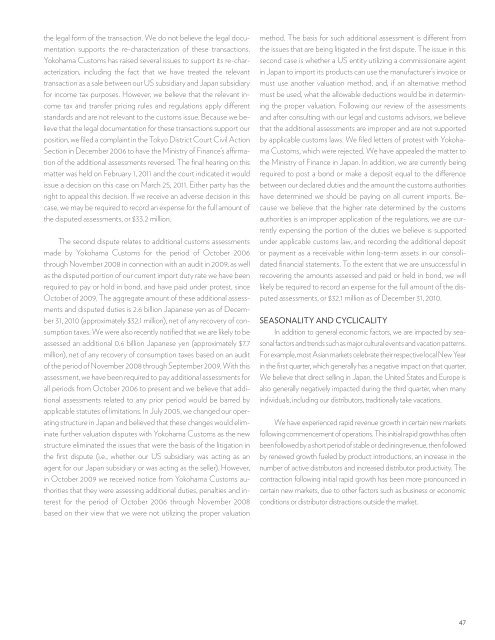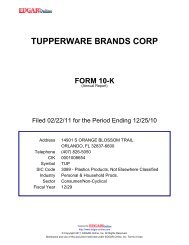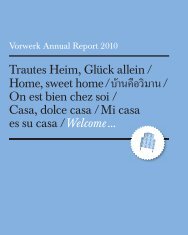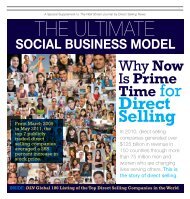Nu Skin 2010 Annual Report - Direct Selling News
Nu Skin 2010 Annual Report - Direct Selling News
Nu Skin 2010 Annual Report - Direct Selling News
You also want an ePaper? Increase the reach of your titles
YUMPU automatically turns print PDFs into web optimized ePapers that Google loves.
the legal form of the transaction. We do not believe the legal documentation<br />
supports the re-characterization of these transactions.<br />
Yokohama Customs has raised several issues to support its re-characterization,<br />
including the fact that we have treated the relevant<br />
transaction as a sale between our US subsidiary and Japan subsidiary<br />
for income tax purposes. However, we believe that the relevant income<br />
tax and transfer pricing rules and regulations apply different<br />
standards and are not relevant to the customs issue. Because we believe<br />
that the legal documentation for these transactions support our<br />
position, we filed a complaint in the Tokyo District Court Civil Action<br />
Section in December 2006 to have the Ministry of Finance’s affirmation<br />
of the additional assessments reversed. The final hearing on this<br />
matter was held on February 1, 2011 and the court indicated it would<br />
issue a decision on this case on March 25, 2011. Either party has the<br />
right to appeal this decision. If we receive an adverse decision in this<br />
case, we may be required to record an expense for the full amount of<br />
the disputed assessments, or $33.2 million.<br />
The second dispute relates to additional customs assessments<br />
made by Yokohama Customs for the period of October 2006<br />
through November 2008 in connection with an audit in 2009, as well<br />
as the disputed portion of our current import duty rate we have been<br />
required to pay or hold in bond, and have paid under protest, since<br />
October of 2009. The aggregate amount of these additional assessments<br />
and disputed duties is 2.6 billion Japanese yen as of December<br />
31, <strong>2010</strong> (approximately $32.1 million), net of any recovery of consumption<br />
taxes. We were also recently notified that we are likely to be<br />
assessed an additional 0.6 billion Japanese yen (approximately $7.7<br />
million), net of any recovery of consumption taxes based on an audit<br />
of the period of November 2008 through September 2009. With this<br />
assessment, we have been required to pay additional assessments for<br />
all periods from October 2006 to present and we believe that additional<br />
assessments related to any prior period would be barred by<br />
applicable statutes of limitations. In July 2005, we changed our operating<br />
structure in Japan and believed that these changes would eliminate<br />
further valuation disputes with Yokohama Customs as the new<br />
structure eliminated the issues that were the basis of the litigation in<br />
the first dispute (i.e., whether our US subsidiary was acting as an<br />
agent for our Japan subsidiary or was acting as the seller). However,<br />
in October 2009 we received notice from Yokohama Customs authorities<br />
that they were assessing additional duties, penalties and interest<br />
for the period of October 2006 through November 2008<br />
based on their view that we were not utilizing the proper valuation<br />
method. The basis for such additional assessment is different from<br />
the issues that are being litigated in the first dispute. The issue in this<br />
second case is whether a US entity utilizing a commissionaire agent<br />
in Japan to import its products can use the manufacturer’s invoice or<br />
must use another valuation method, and, if an alternative method<br />
must be used, what the allowable deductions would be in determining<br />
the proper valuation. Following our review of the assessments<br />
and after consulting with our legal and customs advisors, we believe<br />
that the additional assessments are improper and are not supported<br />
by applicable customs laws. We filed letters of protest with Yokohama<br />
Customs, which were rejected. We have appealed the matter to<br />
the Ministry of Finance in Japan. In addition, we are currently being<br />
required to post a bond or make a deposit equal to the difference<br />
between our declared duties and the amount the customs authorities<br />
have determined we should be paying on all current imports. Because<br />
we believe that the higher rate determined by the customs<br />
authorities is an improper application of the regulations, we are currently<br />
expensing the portion of the duties we believe is supported<br />
under applicable customs law, and recording the additional deposit<br />
or payment as a receivable within long-term assets in our consolidated<br />
financial statements. To the extent that we are unsuccessful in<br />
recovering the amounts assessed and paid or held in bond, we will<br />
likely be required to record an expense for the full amount of the disputed<br />
assessments, or $32.1 million as of December 31, <strong>2010</strong>.<br />
SEASONALITY AND CYCLICALITY<br />
In addition to general economic factors, we are impacted by seasonal<br />
factors and trends such as major cultural events and vacation patterns.<br />
For example, most Asian markets celebrate their respective local New Year<br />
in the first quarter, which generally has a negative impact on that quarter.<br />
We believe that direct selling in Japan, the United States and Europe is<br />
also generally negatively impacted during the third quarter, when many<br />
individuals, including our distributors, traditionally take vacations.<br />
We have experienced rapid revenue growth in certain new markets<br />
following commencement of operations. This initial rapid growth has often<br />
been followed by a short period of stable or declining revenue, then followed<br />
by renewed growth fueled by product introductions, an increase in the<br />
number of active distributors and increased distributor productivity. The<br />
contraction following initial rapid growth has been more pronounced in<br />
certain new markets, due to other factors such as business or economic<br />
conditions or distributor distractions outside the market.<br />
47









